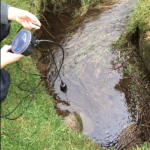Growing concern about the demise of water quality in South…
Results-based payments for farming: delivering high quality biodiversity and other public goods
Paying farmers to deliver better environmental outcomes is the focus of the Results-based Agrienvironmental Pilot Scheme (RBAPS). Dolores Byrne tells us how farmers in Leitrim, the Shannon Callows and Northern Spain are piloting this approach.
What if farmers got paid for the quality of wildflowers, birds and butterflies on farmland in the same way they get rewarded through
markets for the quality of their livestock? That’s the premise behind results-based agri-environment schemes where the level of payments to farmers are related to delivery of quality of the farmed environment.
Between 2014 and 2020, the Common Agricultural Policy will account for 38% of the overall European Union budget. Substantial supports are available through financing of agri-environment schemes to encourage farmers to maintain and improve the quality of public goods such as biodiversity, clean air, and water quality. However, research shows mixed benefits from agri-environment schemes, and the status of biodiversity associated with farmland continues to decline. Maintaining extensive farming practices which sustain High Nature Value farmland and associated habitats and wildlife is essential to halt biodiversity declines. With many emerging constraints on EU budgets, including Brexit, taxpayers want assurance that the monies paid out are being targeted to the right land in the right places – in order words, that farmers are paid according to the quality of their environmental and biodiversity outputs.
Clearly there is a need to create an environmental market place which adequately and fairly values and rewards farmers for the quality of public goods they produce. The Results-based Agri-environmental Pilot Scheme (January 2015- June 2018) is exploring how the Burren model of paying farmers for the quality of biodiversity on their grasslands could work in three pilot locations of County Leitrim and the Shannon Callows (including parts of Counties Galway, Roscommon and Offaly) in Ireland, and the Navarra region of Spain.
The three pilot locations were chosen because they are set within High Nature Value farmland areas and offer contrasting farming methods, climate and physical challenges. Each region focuses on different outputs. In County Leitrim the focus is on semi-natural grasslands and habitat suitable for the rare Marsh Fritillary butterfly. Breeding wader habitat, ground nesting birds and flowerrich hay meadows are being tested along the Shannon Callows.
The Navarra region of northern Spain is testing how results-based approach could work for the mosaic of vine, almond and olive
cropland, a very important refuge for many rare and protected flora and fauna. Different pressures are present on maintaining extensive farming in the three areas. In Leitrim, afforestation and abandonment are seen as the main land use changes, whereas in the Shannon Callows and Navarra, the push is for intensification. Results-based schemes are a farmer-led approach to farming and conservation, which sees farmers paid for both work undertaken and, most importantly, for the delivery of results for the environment.
How does a results-based scheme work in practice?
The project teams in each area have identified result indicators which are used to assess the quality of the farmland for the
measure in which they are enrolled and to indicate general environmental condition. Indicators must be fair to the farmer and be within their control. They must also be reliable indicators of the quality of the target species or habitat which the scheme measure
is aiming to enhance. Taking semi-natural grasslands in County Leitrim as an example, the ‘biodiversity health check’ of a grassland is scored on scale from 0 through 10. Indicators used to assess the quality of the grasslands include the number and cover of positive plant species which indicate low levels of grassland fertility and the cover of negative plant species which can indicate fertilisation and over grazing (e.g.
abundant thistles, docks or ragwort). The assessment also includes indicators for current habitat condition such as extent of bracken, scrub and any damaging activities.
The latter set of indicators acts as threat assessments, highlighting to the farmer practices which might not deliver high-quality species-rich grassland into the future.
“It’s a fair way of doing things. You want to improve on the scores and want to know what you have to improve”– farmer in County Leitrim
Fields which score higher on the RBAPS scale are producing better quality habitat for plants and wildlife; fields that score lower are likely to be more intensively managed land which can support higher stocking rates. The higher the ‘biodiversity health’ of the field, the higher the score and consequently the greater the farmer is rewarded for their time, effort and management.
Paying for results
Payment levels are area based and are linked to the score obtained. Increasing payment is available in increments up to the maximum
payment of score 10. Tiered payment levels provide financial incentives to the farmer to deliver highest quality environmental outcomes in their particular farm setting. Results-based schemes are by their nature tailored to the region and are adapted to local conditions and circumstances. In the Shannon Callows, which is designated for nature conservation, some prescriptions (obligations) accompany the results-based element to maximise potential for breeding wader success. Payments are also available here for undertaking actions, such as creation of wet features such as ponds for breeding waders, which enhance the quality of farmland for these birds.
Are results-based schemes changing the way farmers view their marginal land? It would appear to be the case with the farmers involved in the Ireland and Spain pilot. One farmer enrolled in the Marsh Fritillary measure in County Leitrim said that they wouldn’t have noticed
nature much before the scheme. Now they were stopping to look at the butterflies on their land, and even took photographs of the
ones they found so that they could look them up later to see what type of butterfly was present.
“I know more about what is on the land now. You’d be more interested if you’re getting paid for having the flowers on the land. I always thought they were weeds before this scheme” – farmer in County Leitrim
By putting management choices back in the hands of the farmer better environmental and biodiversity results can be produced through agri-environment measures targeted to individual farms that are more cost-effective for taxpayers. Findings of the results-based pilot scheme will be presented to the European Commission in May 2018 and project partners are liaising with interested communities, non-governmental organisations and government bodies to bring attention to the benefits of resultsbased approaches for agri-environment schemes. Lessons learned from the results-based project are already being transferred into schemes on the ground, including as part of successful European Innovation Partnership projects which are being funded by the Department of Agriculture, Food and the Marine.
Dolores Byrne, Project Ecologist, IT Sligo
Project Co-ordinator: Derek McLoughlin derek@efncp.org
Funders: This project was funded by the European Commission with co-funding provided by project partners and with support
from The Heritage Council, Teagasc and the Department of Agriculture, Food and the Marine.







